A quick search on-line, or a look at any library catalogue in Australia will provide a mountain of information on the Gold Rush,
however the inclusion of this page, is intended to provide a general impression or picture of life as a "Digger Down Unda", some info as to the
working of an 1860s Gold Mine, and incorporate some relevant family events and records.

This is what it was all about - one good nugget could change your life forever!
Image thanks to Wikipedia
THE 1850'S GOLD RUSH IS ON.
The big two questions confronting most of our family of Lead Ore Miners from around Cumberland
and Northumberland, were simply
Head for America or Australia ?
and
Do I take my family with me & risk their well-being on the diggings, or send for them after I've struck it rich ?
BUT FIRST, WE REALLY SHOULD CONSIDER WHO ORIGINALLY MINDED THE COUNTRY OF THE DIGGINGS !

Wathawurrung speaking people Circa 1890s Courtesy Victorian Collections / Federation University Historical Collection
So, before looking into how our many family members made their ways to the Victorian Gold Fields, without getting too emotional, opinionated, or political, perhaps we should respectfully regard a quick overview, from the point of view of the region's original land carers, the three local Wathawurrung speaking clans in the Ballarat district. In the 1830's, after tens of thousands of years of aboriginal tradition and peaceful culture caring for, and sharing every known secret of the seasons, tribal land and law, and of course food and water sources, life drastically changed very rapidly. All of a sudden experiencing strange white men (gubbahs) who talk strange, live strange, and do very unnatural things, like cut down trees as to live in boxes, point noisy shiny sticks to hurt people and animals, and even dig huge holes in the ground that makes the river water fouled.
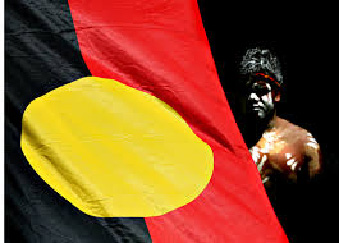
Australian aborigine (also known as Koorie) flag and colours.
The three main local tribes were named after their "country" (or district), being "Burrumbeet" from Lakes Burrumbeet and Learmonth, "Keyeet" from Mt Buninyong and "Tooloora" from Mt Warrenheip and Lal Lal Creek The last well recognised leader of the district, was "King Billy" from Burrumbeet, whose death surprisingly made the newspapers in mining areas and big cities right round the country. Unfortunately even today, many would agree we still don't treat our surviving aborigines, or the vast lands of Australia, with as much consideration and respect as we should. It is recommended to make some time to "Google" some relevant on-line references and images, to formulate your own opinions.
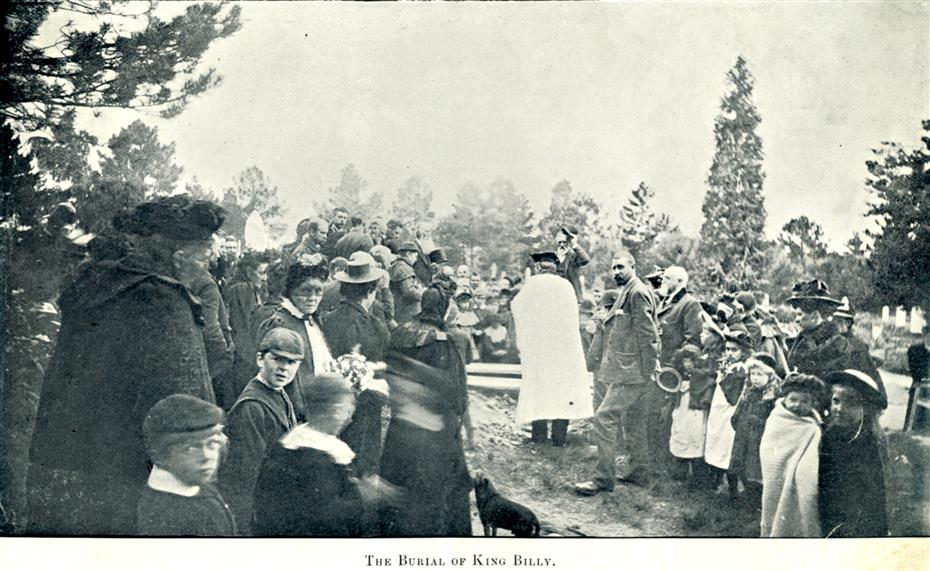
Burial of King Billy (aka Frank Wilson) at Ballarrat New Cemetery in Sep 1896 Courtesy Victorian Collections
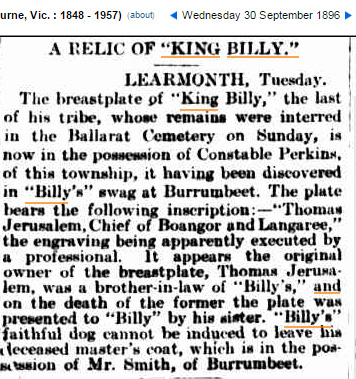
Death notice of "King Billy" who died at Ballarat Hospital in Sep 1896.
OUR FAMILY EMIGRANTS HAD TO DECIDE - AMERICA OR AUSTRALIA ?
Let's just have a brief pause from a heap of historical factual stuff, and take a moment to deliberate upon what every man, woman, and child, had to go through and consider, taking on such a major feat like emigration, back in the 1850s & 1860s.
1. sell everything you own except for 1 suitcase of belongings, to emigrate,
2. organise a horse or buggy ride of over 120 miles, from Cumberland to the port at Liverpool,
3. leave everyone you know, your home town family roots, and almost everything familiar behind.
4. survive a long treacherous voyage of 3-4 months on a sailing ship to Australia on the other side of the world,
5. restart a totally new life with only what you could carry, to a foreign country of a totally different culture, ways & means,
It just seems to make a whole lot of sense to head out, with your single suitcase, for a region of a far-away foreign country, where you have a number of close family connections, old friends and neighbours from home for initial support, and most importantly, a familiar means of survival. Only one of our families in the Passengers listed on the home page, John Hewitson and Mary Ann Forrester and 4 children born in Victoria, returned home permanently to the U.K. The vast majority of the rest of our families, certainly kept the links in the family chains alive, well after they arrived on the Victorian Gold fields, with most of them eventually followed the lead of the Calvert brothers to East Gippsland, many becoming graziers and crop growers later on too.

Emigration record of William Calvert (Junior) & John Russell Calvert - first known family members to go to Victoria in 1853.
THE BASICS OF DIFFERENT OLD TIME GOLD MINING TECHNIQUES IN AUSTRALIA
The easiest way to show and outline the main differences of gold mining techniques of olden days, is to show a few self explanatory old time images.
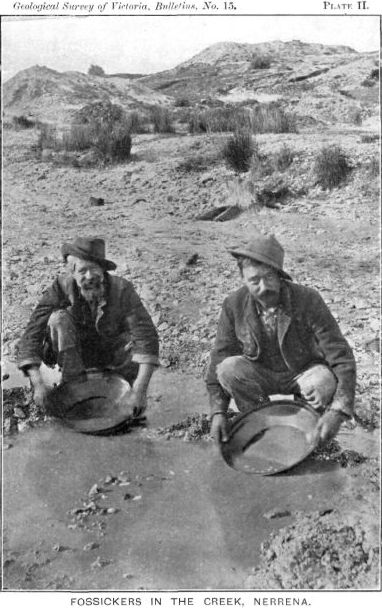
#1 Small time Fossickers above panning for gold specs and small nuggets using creek water - Nerrena creek via Ballarat 1890 - courtesy wikimedia.
Back in the very early 1850s, as the Diggings began to develop, all you needed was a pan or a metal plate, a pick and shovel, and with a good bit of luck in gold bearing country, many made their fortunes. This is probably how many who emigrated started out pre 1860, in a small and affordable method of finding "some colour in the pan".
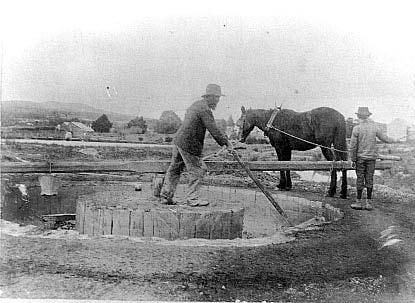
#2 Horse drawn Puddling Machine - Courtesy http://education.sovereignhill.com.au
The puddling machine crushed gold bearing washdirt and mud in a circular hole from a creek bed or mine shaft, with a heavy weight or wheel drawn around in circles by a strong horse.
As time went on, thousands of miners of all types from around the world, brought their experience and knowledge of the latest techniques, equipment, and systems, designed for bulk handling of wash dirt for maximum return. It was big business, which especially needed the support infrastructures for feeding and clothing and housing the miners and their families, and transportation for supply and maintenance of heavy mining gear.
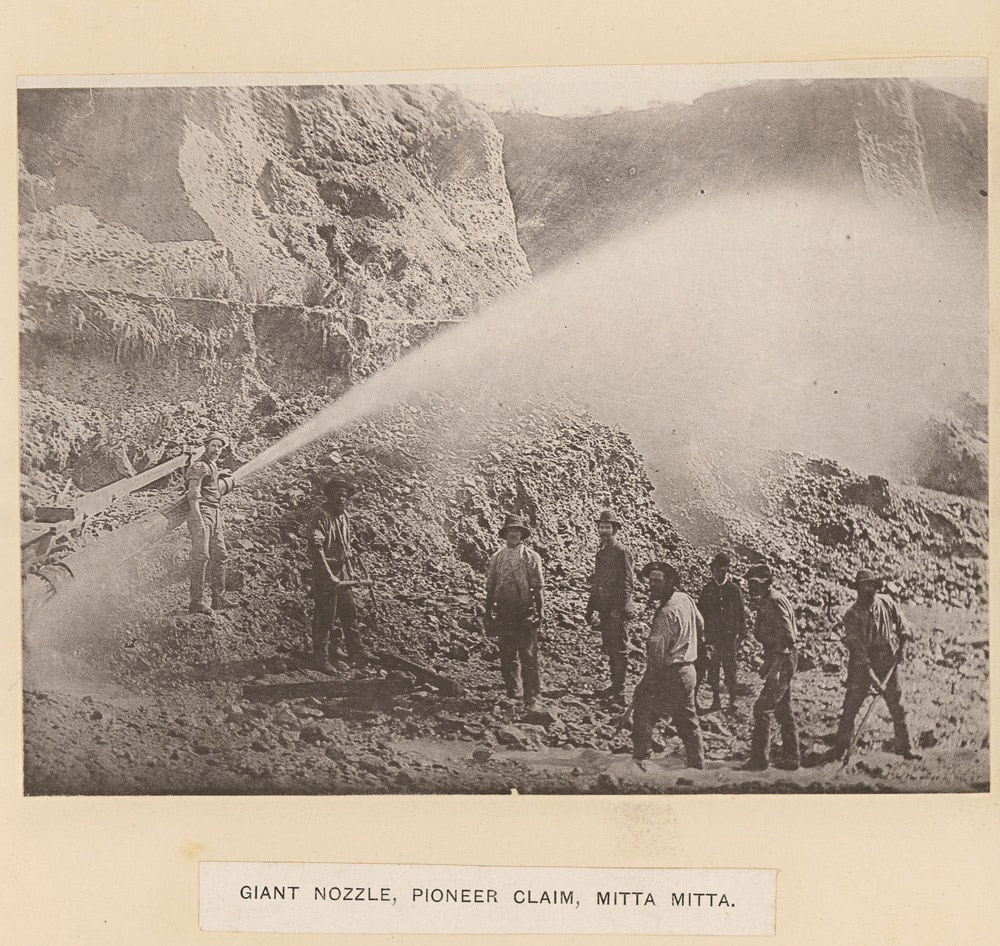
#2 Serious commercial Gold mining operation, a Sluicing / pumping system - washing away huge volumes of gold bearing wash dirt with a 3 inch nozzle, to later be moved and then sluiced (separated by weight ) with water in sluicing boxes. One of Elizabeth Richardson's uncle by marriage, Percival Cochrane worked for the above Pioneer Sluicing company at Mitta Mitta near Beechworth, and tragically lost his life in a land slide on a steep hillside at this mine in 1890.
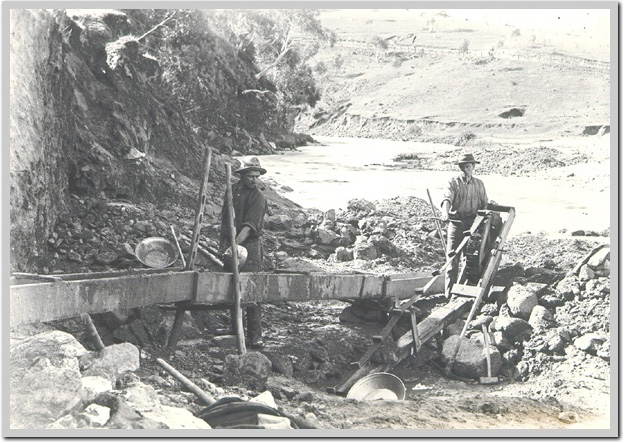
#3 Sluicing box system known as a Californian Pump as used at Mitta Miita circa 1880.
After being pumped out with a nozzle jet of water, the wash dirt was shovelled or poured into the higher end of the ridged sluice box system, and water pumped or channelled down the sluice box, with the gold being the heaviest element, settling at the bottom at the edge of each ridge, ready for collection.
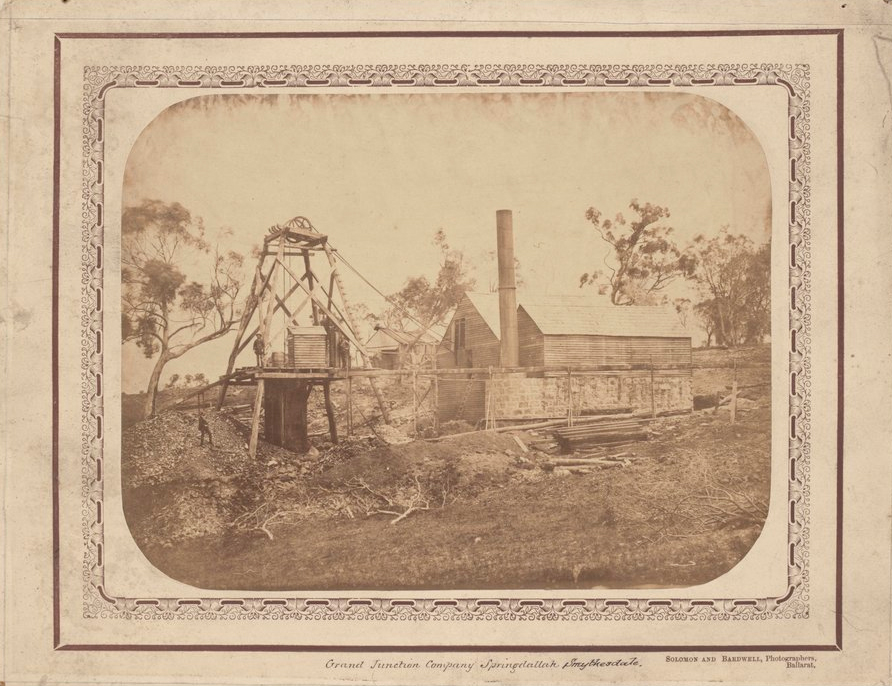
Steam powered Grand Junction Gold Mine at Springdallah 1861, 4 kilometres from Piggoreet - State Library of Victoria.
#4 Another serious commercial Gold mining operation technique, requiring digging of an extensive large mine shaft, utilizing a large steam engine usually housed in a nearby building, designed to haul up the gold bearing diggings (wash dirt) on a pulley and cable system. Mid to large capacity steam engines alone, of up to around 70 inch capacity (cylinder diameter) cost between 3,000 and 5,000 pounds, so a mine had to succeed in order to recover this huge capital outlay. As the industry developed, our Calvert, Coulson, Hewitson, Broadwood, and Liddell family men, networked their resources and skills into similar steam powered commercial mining operations, being the Try Again and Cleft in the Rock Gold mines, near Springdallah.
SOME EXAMPLES OF OUR VERY STRONG PIONEERING WOMEN.
The two sisters-in-law portrayed here, were simply amazing women from the 1830s and 1840s. They grew up in close proximity of each other in Northern England, traversed the same oceans to the other side of the world, suffered similar hardships on the Victorian, and both enjoyed their later years of life as farmers wives in the lush green region of East Gippsland.
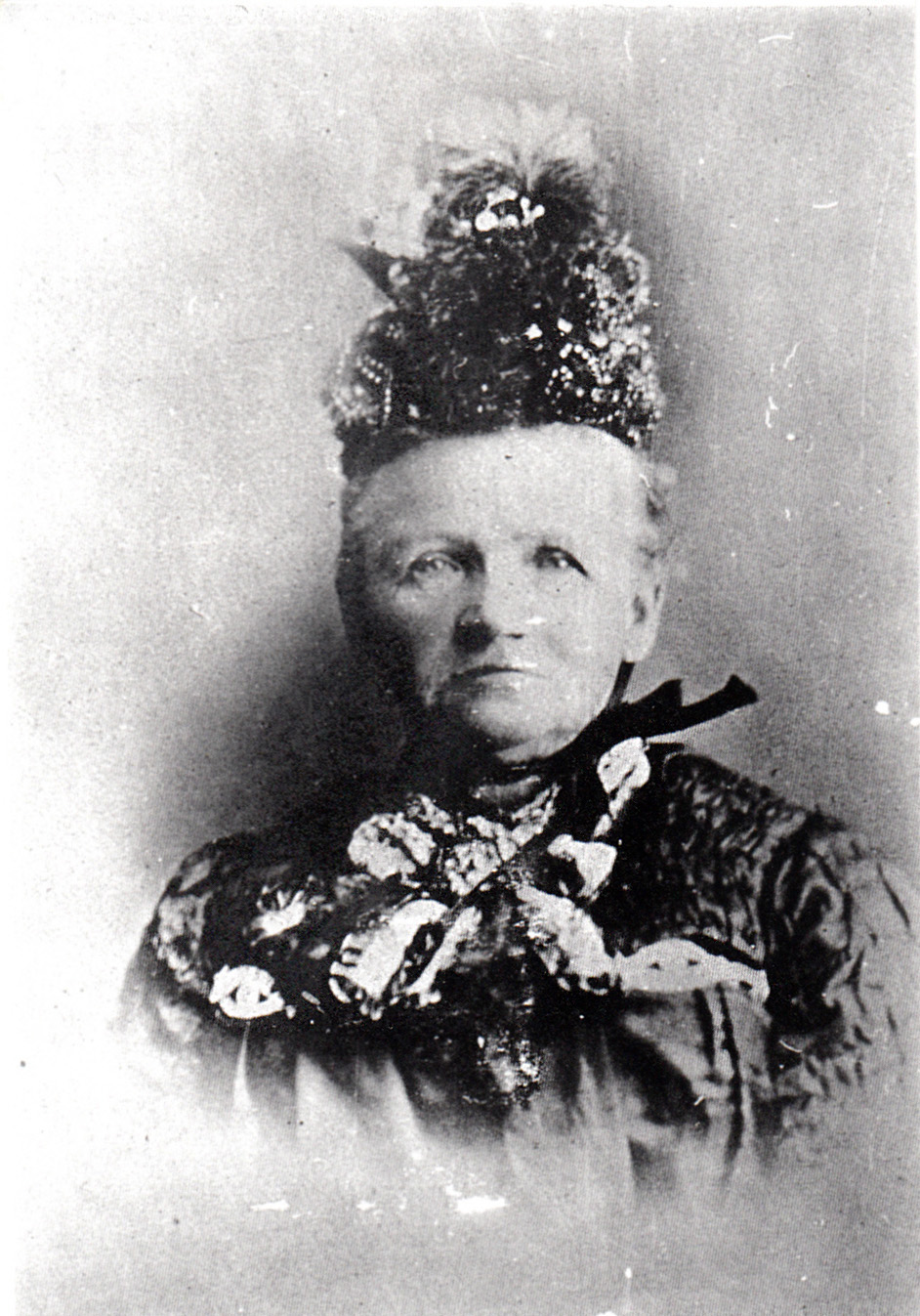


At left, William & John Russell Calvert's sister, Mary Liddell nee Calvert, and right John Russell Calvert's wife Jane Coulson.
Photo of Jane Calvert nee Coulson reproduced Courtesy http://arrow.monash.edu.au/hdl/1959.1/70376
Written permission for reuse - Federation University Centre Gippsland Studies, Monash University Research Repository.
Mary Calvert was born in 1841 in Allendale in Northumberland and her sister-in-law Jane Coulson was also born at Ninebanks via Allendale in Northumberland on the 11th Sep 1833. These two pioneer women seemed to have started a trend, of female family members living close to each other for mutual support, from their situations on the Gold Fields and on farms in East Gippsland, which has flowed through to recent Richardson female relatives, whom have also enjoyed mutual support and relationships of nearby families up until the current decade.
So, here seems an ideal opportunity to also respectfully bring some attention to the roles, in particular that our women family members undertook, during these times, both before and after emigration. In the case of the Calvert Brothers, they both left their respective wives each with a very young boy back home in England, whilst they ventured and sought available opportunities on the Gold Fields near Ballarat.
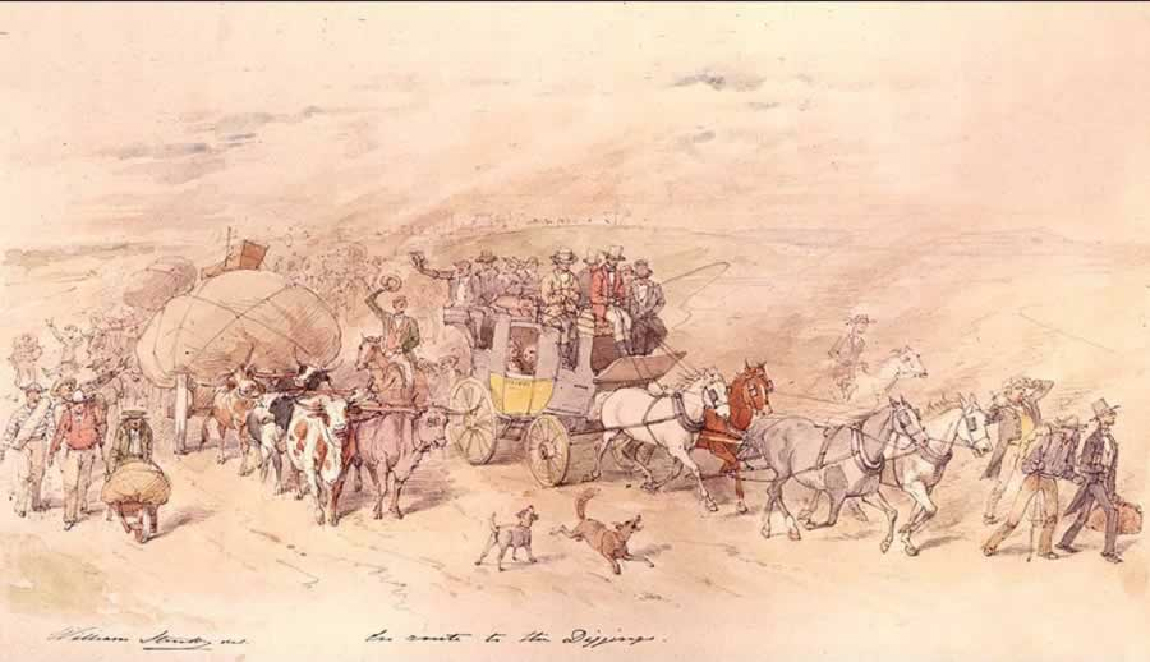
Many basic modes of transport to the diggings. William Strutt, artist, pencil and watercolour 1851 State Library of Victoria.
In round figures, it is about 100 kilometers or 60 miles from Melbourne to the Gold Fields near Ballarat. Like many new emigrants landing in a foreign country, many would have little cash to pay for travel, so if one could arrange a barrow to push their belongings in, arrange a buggy ride, book a horse drawn coach, or even catch a train to Ballarat, it was much better than walking with the crowds with "Gold Fever".
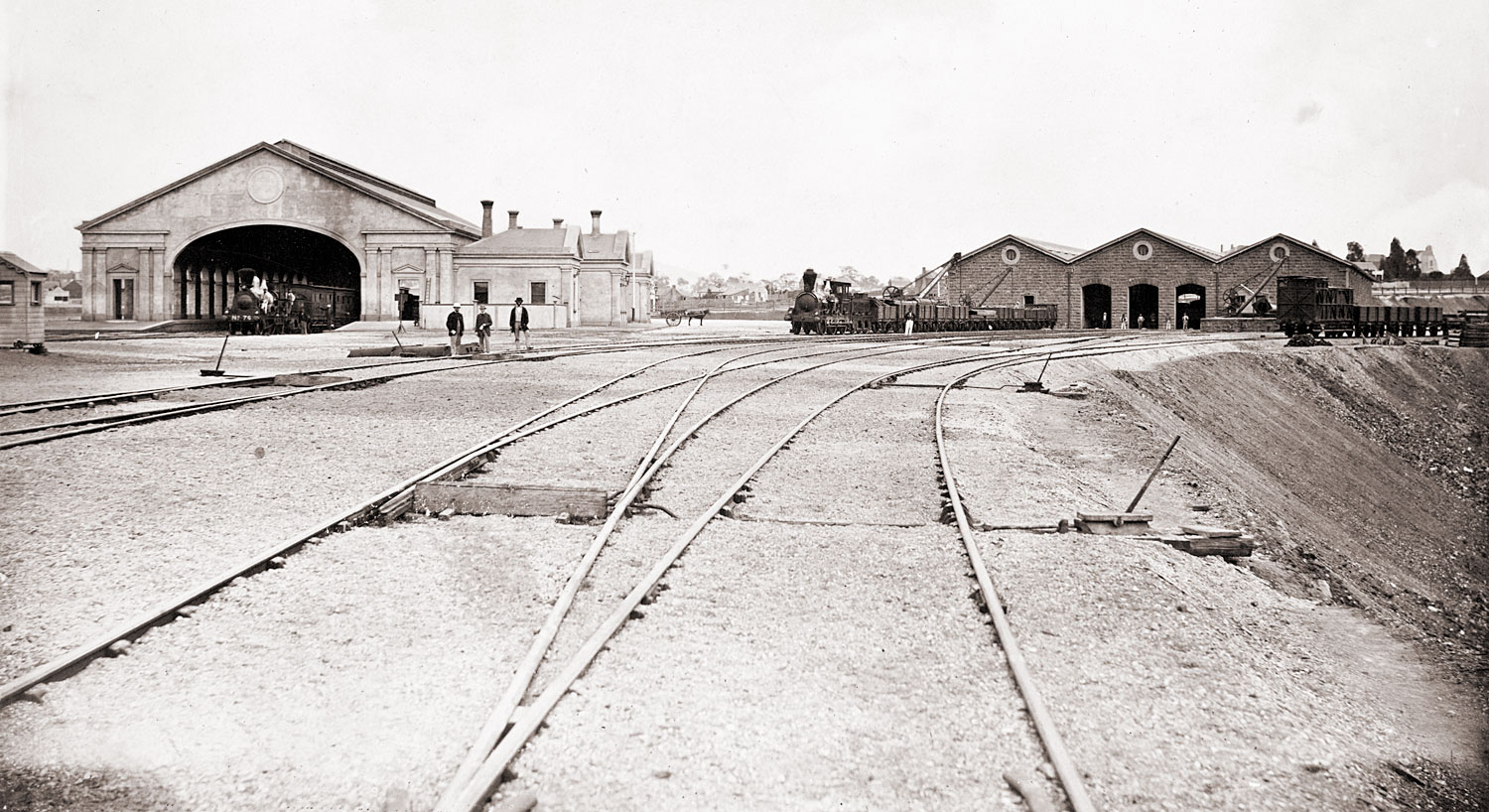
The very impressive Ballarat Railway station circa 1860 - Courtesy State Library of Victoria.
For those coming from overseas whom were "cashed up" so to speak, booking a train ticket to Ballarat station, then a coach ride to meet your partner or friend near their Gold Mine claim, was a very practical, comfortable, and convenient option.
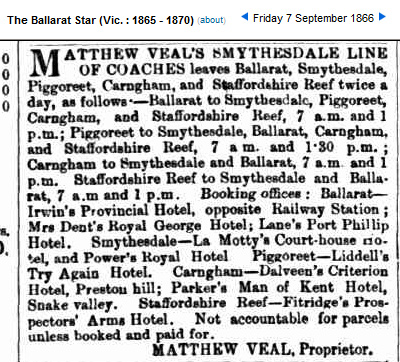
You could catch a Veals stage coach from Ballarat Station to the front of the Liddell's Try Again Hotel at Piggoreet, about one kilometre from the Try Again Gold mine as advertised in the Ballarat Star in 1866.
William Calvert (Junior) sent for his wife Catherine Hewitson and 5 year old son William Hewitson Calvert, over two years later in 1855, and personally picked them up in a horse and cart at Hobsons Bay in Melbourne.

Hobsons Bay 1878 (Port Melbourne) where family arrivals occurred and were recorded on the docks.
On the other hand, John Russell Calvert personally sailed back to Liverpool, spent a few months at home, and returned with his wife Jane Coulson and young son William Coulson Calvert, even later in Dec 1857. What a long period of time to be raising an infant by yourself, and have to fend for and feed two mouths, in northern England, when the Lead Ore industry was in decline!
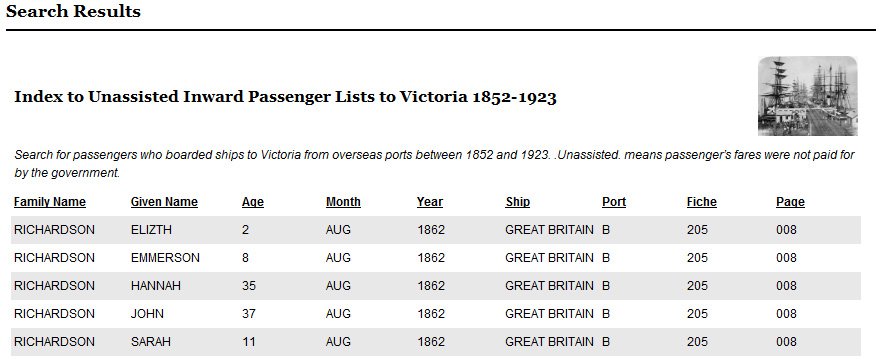
Emigration record of John Richardson and Hannah Allison and their 3 children in 1862.
Others like our first Richardson emigrants, sold up at Alston, with the whole family travelled together. As far as this Richardson family were concerned, they did make it safely across the wild seas to Melbourne in 1862, but to a far different scenario on the goldfields near Ballarat, than their soon-to-be Calvert, Broadwood, and Liddell "in-laws" had experienced much earlier in the mid 1850's.

Map showing Australia, and where Ballarat lies within Victoria, for the benefit of our International visitors.
Research has not been able to find similar examples of share investment records of John Richardson teaming up with other family members - our Richardson family were probably pretty much on their own on the Goldfields near Campbells Creek, apart from some probable personal contact with the Vipond family north of Ballarat near Fryerstown and Nagambie.
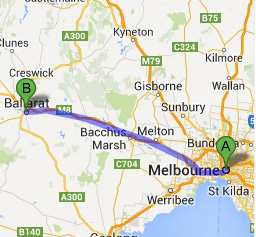
Map showing route from Melbourne to Ballarat - Thanks to Google maps.
This map shows Hobsons Bay (Port Melbourne) marked A, and Ballarat marked B, a distance of 112 kilometres.
Below is a quite old Regional map of mining towns south of Ballarat, where our Richardson, Calvert, Coulson, Liddell, Lee, Hewitson, Broadwood, Cochrane, and Vipond relatives all spent time around the Ballarat region.
and the Viponds are known to have gone much further North to Goldfields near Bendigo and Nagambie.

Local old time Regional Ballarat district map

And for those who appreciate really good old time maps, view this map of Grenville.
Click image to enlarge, then backspace to return.
Towns of significance on this map where any of our above families resided, mined gold, worked, or had children are,
Linton, Haddon, Warrenheip, Smythesdale, Sebastapol, Rokewood, Piggoreet, (aka Devils Kitchen), Newtown, Winters Station / Flat, Spring Creek, and Woady Yaloak.
Then there are some very practical and realistic, yet rather saddening personal aspects to consider, in regard to day to day living, and survival of these strong pioneering women. Imagine living in a tent, with all your worldly possessions in a suitcase stuck in the mud, your sleeping roll or stretcher on the floor, tending for your husband and young children, during Winter temperatures of often minus 5 degrees Celsius and Summers over 40 degrees. Definitely no chandeliers or upstairs servants to help one dress, or say a kitchen hand to cart water from the creek, let alone a butler to go out and trap or shoot a rabbit for dinner. Across the spectrum of our 10 female emigrants on our Passenger List, they lost 6 infants who did not reach 1 year old in Victoria, a further 2 children who did not have a second birthday, and another boy did not live past 9 years of age, which probably reflects both the state of Midwifery and Health services of those times, plus of course the extremely harsh living conditions.
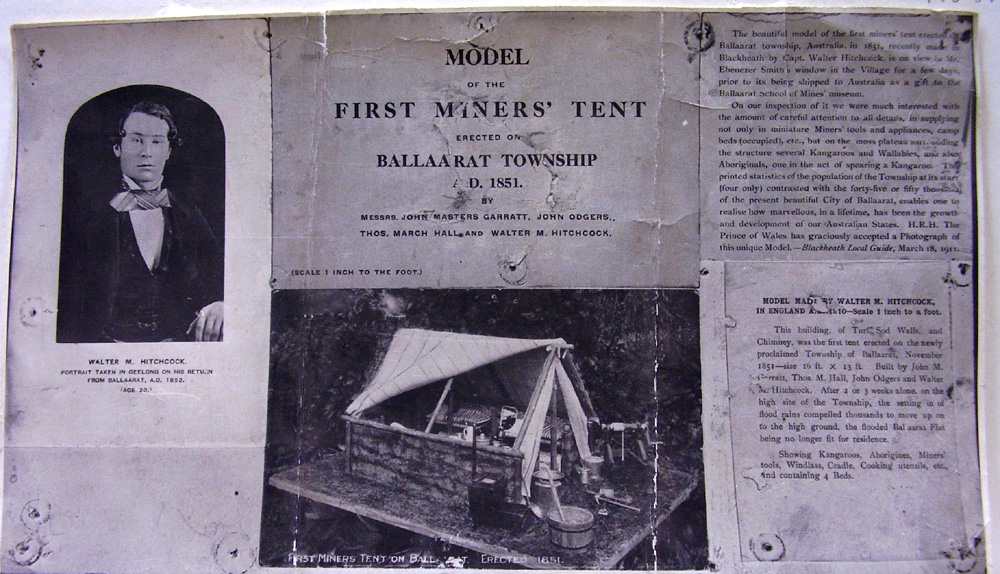
EGold Heritage Publication of recommended Miners tent construction from nearby Geelong in 1851.
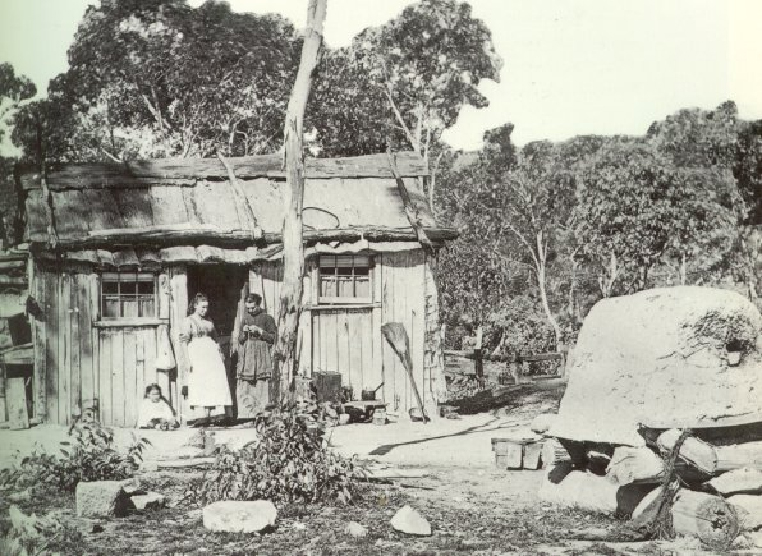
Well established Pioneers bark roof hut with an outdoor oven around 1880s - Courtesy www somewhere.
A GRUESOME FAMILY DEATH ON THE GOLD FIELDS
(if you don't like bad news, skip the next 2 paragraphs)
It also seems relevant to include a brief overview, of Sarah Richardson shown above the map, as arriving in Victoria aged 11 in 1862. Sarah was perhaps the most unluckiest of all our women folk on the family Passenger List. Six years after her arrival on the Gold Fields, at the age of 18 she married William Bell late in 1867, a 28 year old miner, son of Thomas Bell and Margaret Martin from Northumberland. They spent some time at Cambrian Hill, where William had invested in 5 Shares in the Alston and Weardale Gold mine, valued at 7 pounds 10 shillings in Feb of 1867. Sarah fell pregnant and they had their first son John Joseph Bell in 1868 at Cambrian Hill, anout 6 miles south of Ballarat. There was a job as an Engine Driver advertised by Mr W Dickinson, the manager of the Speculator Gold mine at nearby Winters Flat in March of 1869, so William took the job.
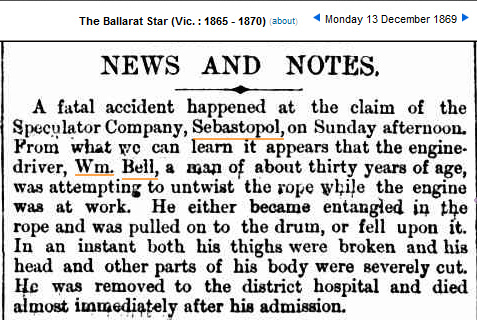
Sad news for the Richardson Family with the death of Sarah Richardson's husband William Bell.

To indicate how dangerous mining was, of strange coincidence, here are deaths of 2 different miners named William Bell listed, both died in a mining accident, both occurring at Smythesdale, happening only 3 weeks apart! By the way, the Ballarat and District Genealogical Society web site, is very informative and pictorially pleasing, and is well recommended for regional research. Another well respected fantastic document on the earliest known history and development of the Ballarat District, is that titled "The History of Ballarat from the first pastoral settlement to current time" by William Bramwell Withers, a great Ebook by Project Gutenburg Australia.
Sarah Bell nee Richardson became pregnant again in 1869, and had a second son William Emerson Bell at Campbells Creek about 50 miles north of Ballarat near Castlemaine. Sadly William Emerson Bell never met his father William, who suffered a rather horrible death mining at work, a few months prior to his birth, as reported above. There has been no record located as to when Sarah and her two boys moved to East Gippsland, probably to be close to her family at Swan Reach. We believe the name William Emerson Bell, was chosen in respect of his father William Bell, and also in regard to Sarah's only brother Emerson Richardson. However Sarah Bell did move on from the past, and remarried Joseph Race, a grazier in Jan 1877 however our Sarah died as Sarah Race the same year aged only 27.
SOME INNOVATIVE AND MULTI SKILLED MEN OF THE FAMILY.
It seems more than fair to follow up the credit and kudos given the above mentioned ladies from our Family Passenger List, with a reasonable mention of a few of our men folk. From the impression outlined, life and survival were definitely tough and harsh on the Victorian Gold Fields for our ladies and children, however the struggles and pressures for our blokes, were just as hard, but in fairly different ways. Let's not forget these gents were from a totally foreign land on the other side of the globe, and came from a very different background of Lead Ore mining techniques.
For example, working in a Gold Mining shaft in Victoria, was extremely dangerous, as they were subject to cave-ins and flooding, suspect cabling and pulleys powered by often unsafe steam engine setups, plus a multitude of other causes of injury and death, as listed in a huge database of Mining Accidents, listed at www.ballaratgenealogy.org.au. Being physically fit and mentally alert whilst on a mining site in those days could be described as crucial to ones survival, which sadly was not the case with our Percival Cochrane, originally from Bamburgh near the north east coast of England.
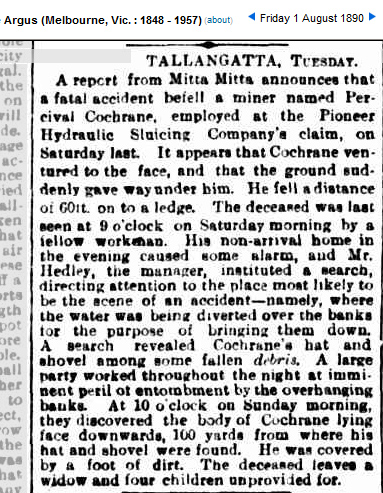
Death notification of Percival Cochrane killed by a land slide at the Pioneer Sluicing Company at Mitta Mitta in Aug 1890.
On the other hand, there appears a cross section of the family whom were destined to survive, and be very successful - even innovative and entrepreneurial. Pictured below at the left, is one of your web host's 2nd Great Grandfathers, Joseph Liddell born in Allendale Northumberland U.K. in 1844 to Joshua Liddell and Mary Coulson, and youngest brother of John Liddell from Piggoreet. Although there is not a great deal of evidence of financial successes on the Gold fields since he married Mary Calvert there in 1866, till he moved to Bairnsdale around 1878 or 1879, he did manage to secure 2 farm blocks at Nicholson, (now the Nicholson River Winery), plus 2 large houses for retirement in East Bairnsdale, before he passed away there in 1910, aged 66.




 From Joshua Liddell born 1807 at Ninebanks, U.K.
From Joshua Liddell born 1807 at Ninebanks, U.K. From William Calvert born 1791 at Kirkhaugh, U.K.
From William Calvert born 1791 at Kirkhaugh, U.K.
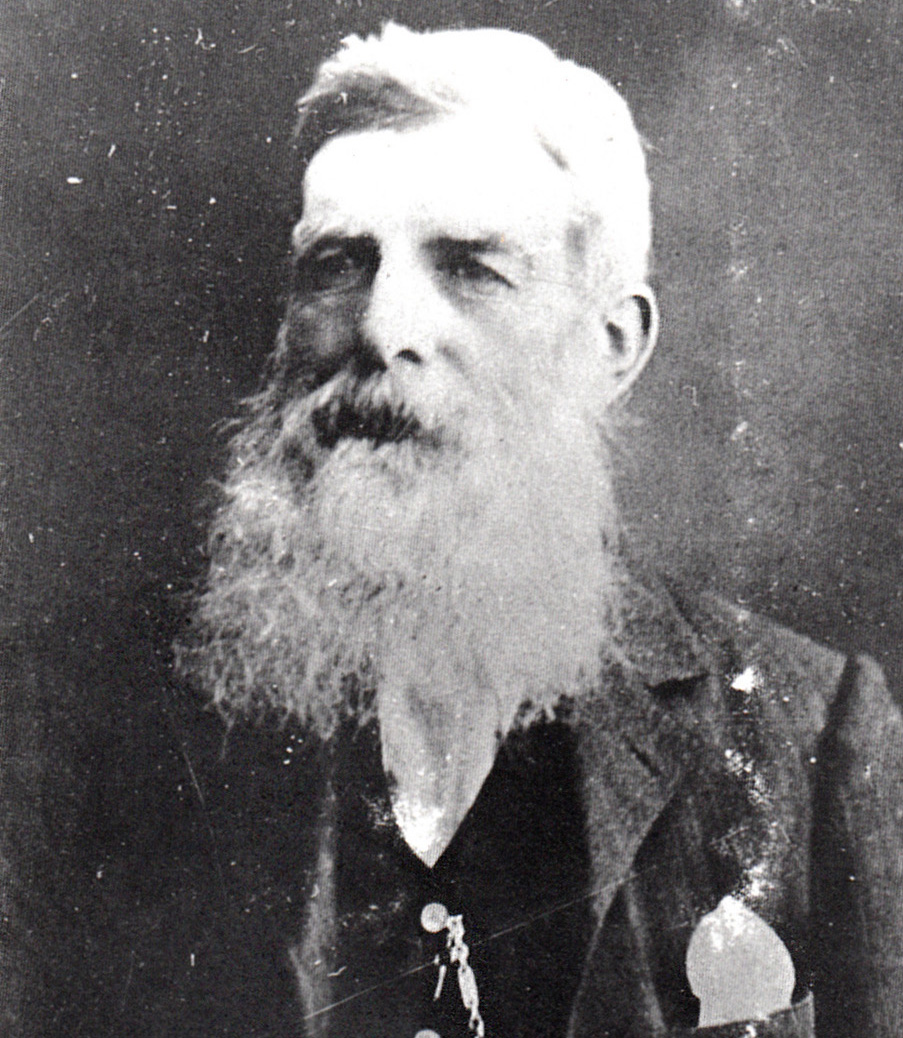

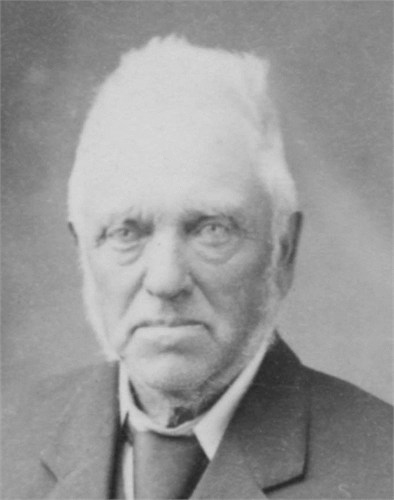
At left, Joseph Liddell born 1844 from Allendale, and right, older brother-in-law John Russell Calvert born 1831 Stotgill UK. Photo of John Russell Calvert Courtesy http://arrow.monash.edu.au/hdl/1959.1/70376
Written permission for reuse - Federation University Centre for Gippsland Studies, Monash Uni Research Repository.
John Russell Calvert, born to William Calvert (senior) from Kirk Haugh and Eleanor Allison from Alston, appeared to be a key player in networking family investments in Gold Mines mainly south west of Ballarat, whether he and his family were living locally until 1862, or after that year when he continued to make multiple Gold Mine Shareholding purchases with other family members, whilst living near Wy Yung on the Mitchell River in East Gippsland over 400 klms from Ballarat.
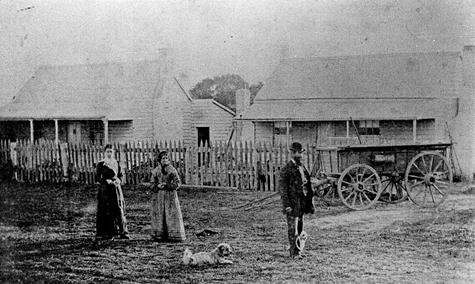
Image of life in Scarsdale in 1880 - Courtesy State Library of Victoria.
These two typical hard working "Aussie blokes", Joe Liddell and John Calvert, were actually brothers-in-law, and the simplest way to describe how the Calvert, Coulson, and Liddell clans were related, is to mention that Joseph Liddell's eldest son, ( our researchers great grand father ) was William Couslon Calvert Liddell, was born in 1875 at Scarsdale on the Gold fields. The Coulson part of his moniker was named from his grandmother's maiden name, Mary Coulson born in Allendale U.K. in 1814, and Calvert was derived from his mother's maiden name Mary Calvert, born Allendale in 1841.
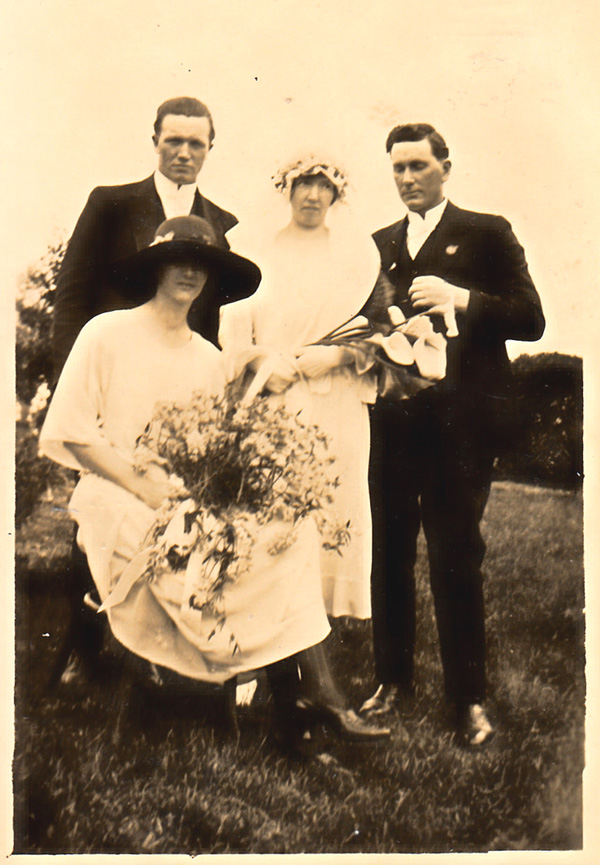
From left at rear, William Coulson Calvert Liddell (Bill), his daughter Annie Liddell and his new son-in-law John Victor (Jack) Richardson, and in front, Jack's youngest sister Ellen (Nennie) wearing the hat. This photo is also taken on Jack and Annie's wedding day, 30 Oct 1922 at Nicholson in Victoria, and is the only known picture of William Coulson Calvert Liddell.
GOLD MINE SHARES AND OTHER MINING INTERESTS
A short list of confirmed family Gold Mining Companies (and one Quartz Company), from the Ballarat region, is listed here -
Try Again Gold Mining Company - at Piggoreet
Cleft in the Rock Gold Mining Company - at Piggoreet
Atlas Gold Mining Company - at Piggoreet
Rose Hill Gold Mining Company - at Creswick Road Ballarat
Golden Stream Gold Mining Company - at Scarsdale
Nelson and Wellington Gold Mining Company - at Sebastopol
Pioneer Extended Gold Mining Company - at Bulldog
Durham Gold Mining Company - at Swamp Lead, Lake Wendouree
Alston and Weardale Gold Mining Company - at Cambrian Hill
Peru Gold Mining Company (Smythesdale Racecourse - sample scrip shown here)
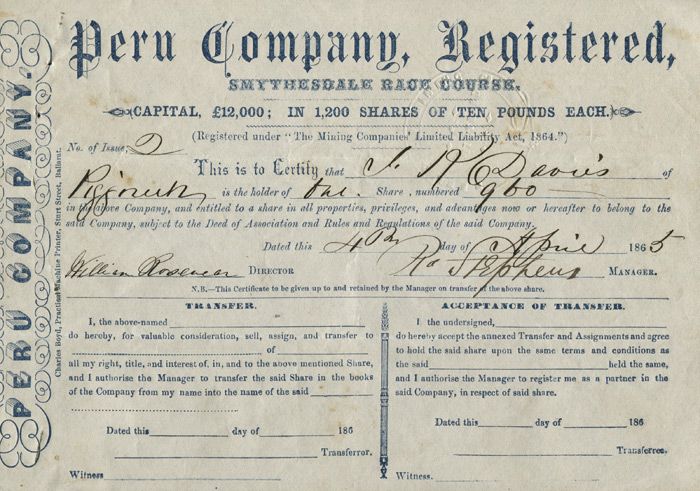
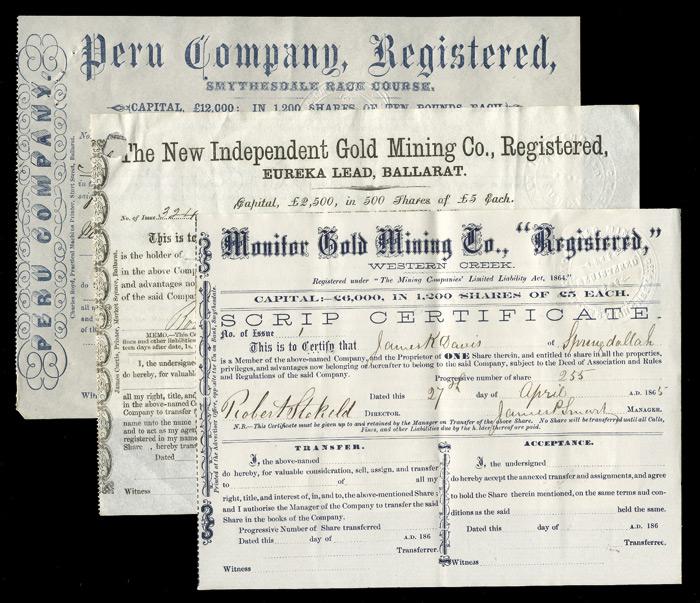
Samples of The Peru Gold Mining Company Share Certificate (Scrip), of the district.
Sons of Freedom Gold Mining Company - at Linton
Cressy Grand Confluence Gold Mining Company
Unicorn Gold Mining Company - at Bulls Run, Sebastopol
Great Estate Gold Mining Company - at Pitfield
Woady Yaloak Extended Gold Mining Company - at Woady Yaloak
Speculator Gold Mining Company - at Winters Flat via Sebastopol
Warrior Gold Mining Company - at Ballarat
Daniel Webster Gold Mining Company - at Ballarat
and
Morning Star Quartz Mining Company - at Yandoit
Gold Mining Company share records from Victoria, in the actual 1850's may be described as "rare as hen's teeth". However, seemingly endless research hours have gone into searching and locating a "digital pile" of Victorian newspaper cuttings, from the early 1860s. As a collective group, our family members had financial investments in about 20 different registered Mining Companies throughout Victoria, from the late 1850s into the 1890s, primarily located south west of Ballarat, with a few others nearer to Castlemaine, Bendigo, Beechworth, and Stawell. It seems logical to focus on the two most relevant family Gold Mining Company interests, being the Try Again and Cleft in the Rock Gold Mines, at Devils Kitchen / Piggoreet.

A classic photo of the Try Again Gold Mine circa 1860, courtesy Victorian Public Records Office and Joan Hunt.
Click here for an in depth review of the workings of the Try Again Gold Mine

THE TRY AGAIN HOTEL AT PIGGOREET
owned by John and Jane Liddell.
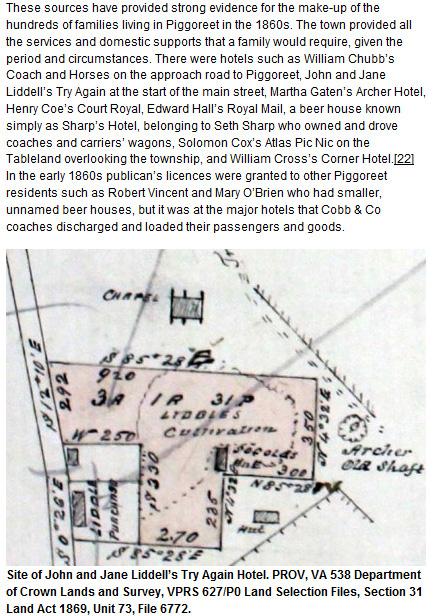
Liddell's Plan courtesy Victorian Public Records Office and Joan Hunt.
The eldest Liddell son John who emigrated to the Victorian Gold fields, owned and ran the Try Again Hotel at Piggoreet with his wife Jane Liddell nee Lee, which was next door to the old Archer shaft, as shown above. From what we have gathered, John and Jane Liddell's Hotel was named after the Try Again Gold Mine, was located in the main street of Piggoreet, situated approximtely 1 kilometre north of the Try Again mine shaft, ie. over Sugarloaf Hill that lies in between Piggoreet and Devils Kitchen.
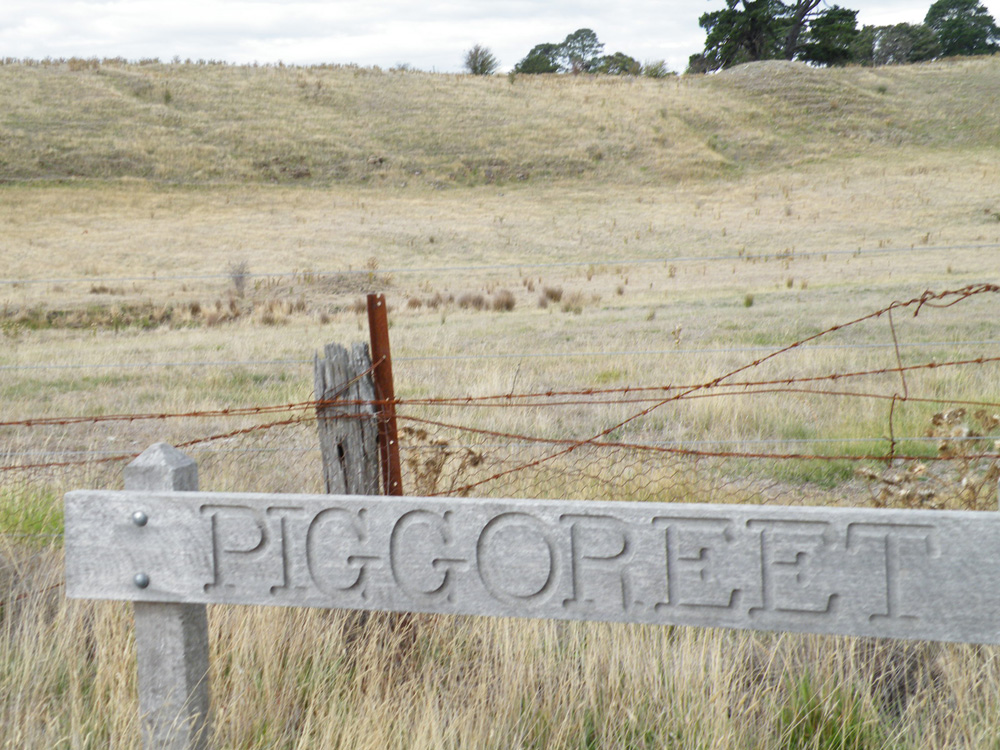
Site of The Try Again Hotel at Piggoreet in 2015 - Courtesy Researcher Mixo Sydenham.
Modern day view of the top end of the main street of Piggoreet. The mullock heap on the top of the hill in front of the larger trees is the remnants of the Archer Gold Mine, shown in the above map. The Try Again Hotel was adjacent to this shaft on the rise, and futher up to the left was a small chapel, and the Liddell's old neighbours from Allendale Northumberland, Mathew and Ann Clementson.
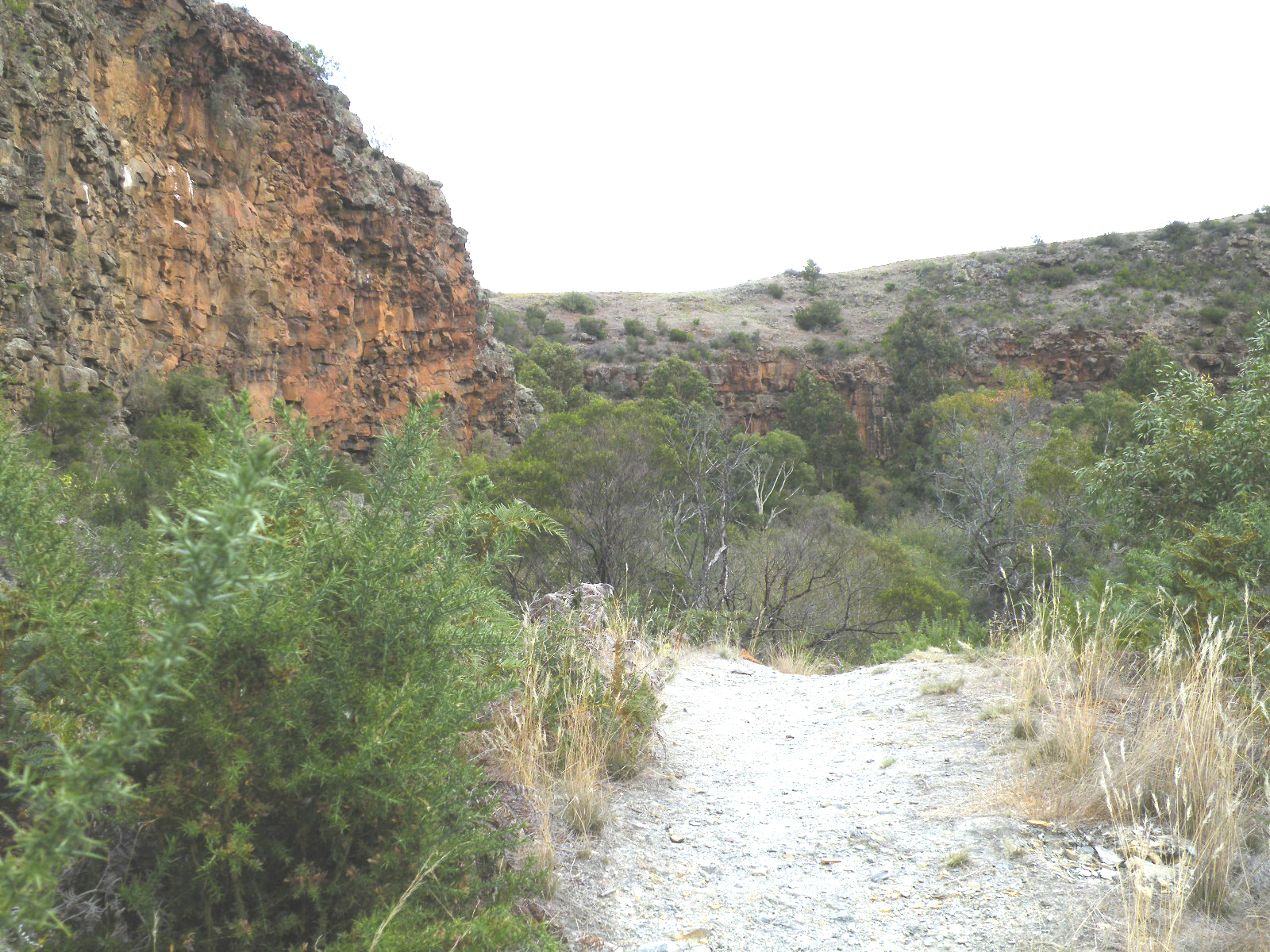
Site of The Try Again Gold Mine at Devils Kitchen in 2015 - Courtesy Researcher Mixo Sydenham.
It's of interest to also note the close proximity of the Cleft in the Rock Gold Mine at the bottom end of Piggoreet, to the Try Again mine shaft on the other side of the hill at Devils Kitchen, as officially reported late in 1860 as
"The gutter which the Cleft of the Rock Co. found is below their tunnel", as the Cleft in the Rock Co,. was a also major family concern too. So these very closely related Diggers, the Calvert, Coulson, Liddell, Broadwood, and Hewitson family members didn't have to go too far, for a Ballarat Beer after a hard day at the mine site, at what was simply known by the locals as "Liddells", and at times for those who had a room there "Janes Place".
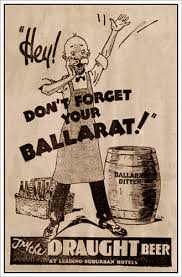
"Hey - Don't forget your Ballarat !"
John Liddell was also a shareholder in the Try Again Gold Mine. Basically all these cousins and in-laws, except for John Liddell, struck enough gold, or saw the advantages in moving on to buy or select land in East Gippsland well before John and Hannah Richardson's family arrived.
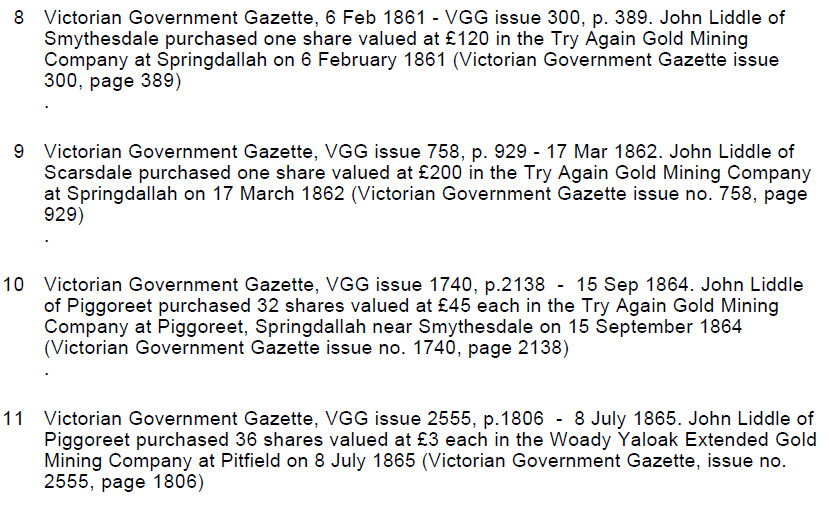
Summary of Gold Mining Shares held by John Liddell from the Victorian Government Gazettes.
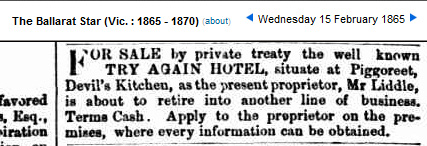
John and Jane Liddell nee Lee attempted sale of the Try again Hotel fell through in 1865.
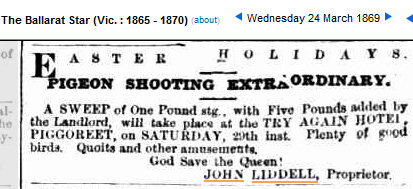
One of many activities organised by John and Jane Liddell, to help generate income in 1869.
John and Jane Liddell could be described as two of Piggoreet's more colourful characters around town, in the 1860s and 1870s. Follow the link here for a better overview of this Liddell family.
Click here for more details of John and Jane Liddell

From Joshua Liddell born 1807 at Ninebanks, U.K.
Also recommended reading is a fantastic summary of the Township of Piggoreet where many of our family lived and worked, courtesy of Joan Hunt and the Victoria Public Records Office.

Seems like an ideal spot, to blend in our own family "voice from the past" so to speak, direct from the Eureka Stockade in the heart of Ballarat, in order to provide a realistic and accurate impression, of emigrating to the Victorian Goldfields. This story has also been partially confirmed from an interview with John Robert (Jack) Cunningham, a great nephew of William Coulson Calvert Liddell, who stated family recollections of the Calverts experience on the Goldfields as "Sitting around quietly in their tent, on the edge of Ballarat, in 1854, while the miners rebellion of the Eureka Stockade, at Bakers Hill occurred." Another very similar description of this event, has also been noted from a great source of family recollection, being those of Ethel St John per "The Calvert Story".
William Calvert mentioned above, was a great uncle of Annie Richardson, and with his wife Catherine nee Hewitson, they had only one son William Hewitson Calvert. As a tribute after the death of his mother, William Hewitson Calvert contributed the following (truncated) story in 1913 for publication in his local newspaper at Forbes in New South Wales.
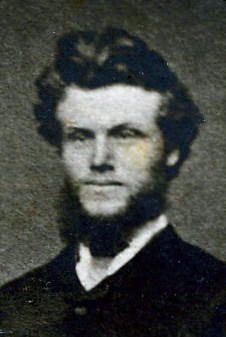
William Hewitson Calvert - born 1850 Allendale UK died 1926 Penrith, New South Wales, Australia.
"My father, William Calvert, and his brother John {Russell} Calvert arrived in Melbourne in 1853. On their way to Ballarat gold fields they did a few weeks' harvesting at Moonee Ponds for Mclntosh Bros., as the wages wore good — 30/- a day and 'tucker' and it was difficult to get men at that. Hay was worth £40 per ton. They were at the Eureka 'riot', so miscalled, as the 'diggers' were persecuted and forced to rise and protest against the treatment they received from the police and Government officials. For example, the sinking on, the gravel pits flat of Eureka was very wet."

Typical diggers tent life near Ballarat circa 1865 - Courtesy National Library of Australia.
Original oil painting by Edwin Stocqueler.
"A policeman would come along frequently and demand to see a digger's mining rights. Perhaps it was in his tent, fifty yards away; but he was not allowed to go to get it. The policeman would then take him away to Camp Hill and chain him to a stump or log, sometimes all night, as there, was no gaol. Then the 'digger' would be brought before the Magistrate and fined for not having a miner's right on him. Captain Wise, who was in charge of soldiers from Melbourne, was astonished when he heard the diggers' cause after the stockade incident, and said he had no idea the men were so persecuted.
Nuff sed!
On March 25th 1855, my mother (Catherine Calvert), and I arrived in Melbourne, per 'Red Jacket' after a voyage of three months from Liverpool, accompanied by some neighbours from Northumberland, Éngland. My father met us in Melbourne, and then started for Ballarat in a covered-in cart containing goods and chattels. Other carts were on the same track, and they travelled and camped together, as there were bush-rangers about in those days, and the men watched turn about throughout the night, with guns ready. One night they sighted a man prowling about, so they promptly challenged him and made him a prisoner, as he would not give any account of himself. After daylight they gave him some breakfast and told him to go. No doubt he was acting as a spy."
"Father followed mining at Ballarat and Smythesdale for some years, then he and his brother selected land at Bairnsdale, Gippsland, in 1862. His brother looked after the fencing-in of the land selected. Then we all went to Bairnsdale in I866, and started farming and fattening cattle. Father {William Calvert Snr}, Uncle {John Russell Calvert}, Cousin {William Coulson Calvert} and I took a mob of 'fats' to Melbourne in 1868.
In 1870 we had big floods which destroyed a lot of wheat, oats, and barley, and took the thrashing machine and winnower three miles down the river. But we recovered them again. They had over one thousand bushels thrashed out and cleaned, and, a lot more in stacks, which floated away and went to pieces."
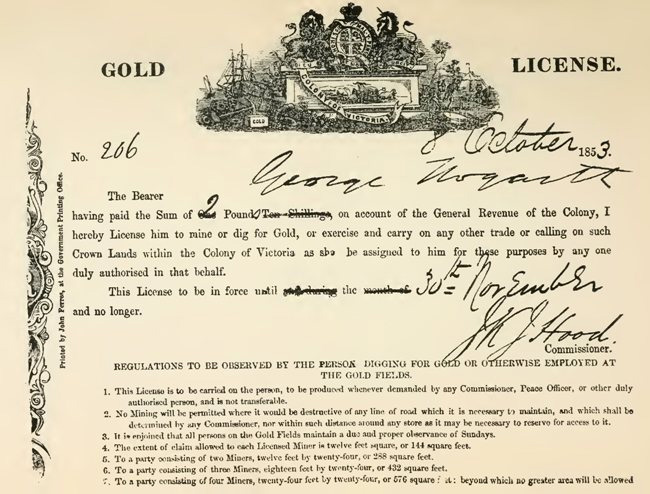
Gold License from 1853, showing increased fees the diggers weren't happy about.
So this blast from the past, a direct quote from our past cousin William Hewitson Calvert, paints a pretty accurate picture of life and times, when the diggers revolted against Policies, Laws, and huge increases in Gold Mining Licence fees. For more info re Eureka Stockade rebellion, go to State Library of Victoria or australia.gov.au.

Back to Site Index.

Background into Lead Ore Mining in Northern U.K.

Background into the Gold Rush days near Ballarat Victoria.

From Joseph Richardson born 1721 at Alston, U.K.

From John Richardson's descendants from 1863 born in Australia.

From John Allison born in 1801, Alston U.K.

From John Armstrong born in 1705, Haltwhistle U.K.

From Thomas Bell born 1806 of Allendale, U.K.

From James Broadwood born 1796 of Northumberland, U.K.

From William Calvert born 1791 at Kirkhaugh, U.K.

From John Clementson born 1692 in Garrigill, U.K.

From William Coulson born 1760 in Cumberland, U.K.

From Robert Cochrane born 1778 in Eglington, U.K.

From Edward Hewitson born 1794 in Kirk Linton, U.K.

From John Liddell born 1880s in Ninebanks, U.K.

From Joseph Parker born 1810 at Allendale, U.K.

From James Rowe born 1765 in Cornwall, U.K.

From Nicholas Vipond born 1655 in Alston, U.K.

Letters from by James and William Armstrong in the 1860s.
Email here re enquiries, corrections, or input to this site